The Eighth Report of Fukushima Prefecture Health Management Survey was released on September 11, 2012.
The thyroid examination section of the survey is shown in this link.
http://www.pref.fukushima.jp/imu/kenkoukanri/240911siryou2.pdf
It contains new thyroid examination results from the first five months of Fiscal Year Heisei 24 (FYH24), from April 1 through August 24, 2012. The results revealed that 18,358 (43.12%) of 42,060 children, mostly from Fukushima-city, Fukushima, had thyroid ultrasound abnormalities. Together with 38,114 children (13,645 or 35.8% had thyroid ultrasound abnormalities) tested in the last half of Fiscal Year Heisei 23 (FYH23) from October 2011 through March 2012, a total of 32,003 (40.0%) of 80,174 Fukushima children have been found to have ultrasound abnormalities.
44,959 of 53,619 eligible Fukushima-city children actually underwent the examination, together with 216 from municipalities which were covered in the FYH23 examination. The report includes the examination results up to August 24, for 42,060 children whose results were complete.
On the day of the release, it was announced that one child from the FYH23 (FY2011) examination had been diagnosed with thyroid cancer after the secondary examination. (This child is apparently one of the 14 children, who actually underwent biopsy, of the 60 children who qualified for secondary examination).
The new report also includes a size category of nodules and cysts between 3.1 and 5.0 mm for both the new FYH24 (FY2012) results as well as the old FYH23 (FY2011) results.
FYH24 (FY2012) implementation schedule includes the following municipalities:
September to early October 2012: 18,061 children from Nihonmatsu, Motomiya and Otama.
Early to mid October 2012: 4,757 children from Koori, Ten-ei, and Kunimi.
Mid October to late November 2012: 14,655 children from Shirakawa, Nishigo and Izumizaki.Early October 2012 to late March 2013: 64,478 children from Koriyama.
Mid January 2013 to late March 2012: 3,139 children from Miharu-machi, the only municipality whose residents were administered stable iodine prophylaxis.
*****
Note:
H23 refers to Heisei Year 23, which is the same as 2011.
FYH23 refers to Fiscal Year Heisei 23 which runs from April 1, 2011 through March 31, 2012.
H24 refers to Heisei Year 24, which is the same as 2012.
FYH24 refers to Fiscal Year Heisei 24 which runs from April 1, 2012 through March 31, 2012.
*****
For a complete English translation of the thyroid examination section of the Sixth and Seventh Reports of Fukushima Prefecture Health Management Survey, please refer to these links.
http://fukushimavoice-eng.blogspot.com/2012/07/thyroid-examination-by-fukushima.html
https://docs.google.com/file/d/0B68f83tqq7QuZUdCZXhTLVl2dEE/edit?pli=1
The Eighth Report of Fukushima Prefecture Health Management Survey (excerpt)
September 11, 2012
Page 15
Summary of Thyroid Examination Results ①
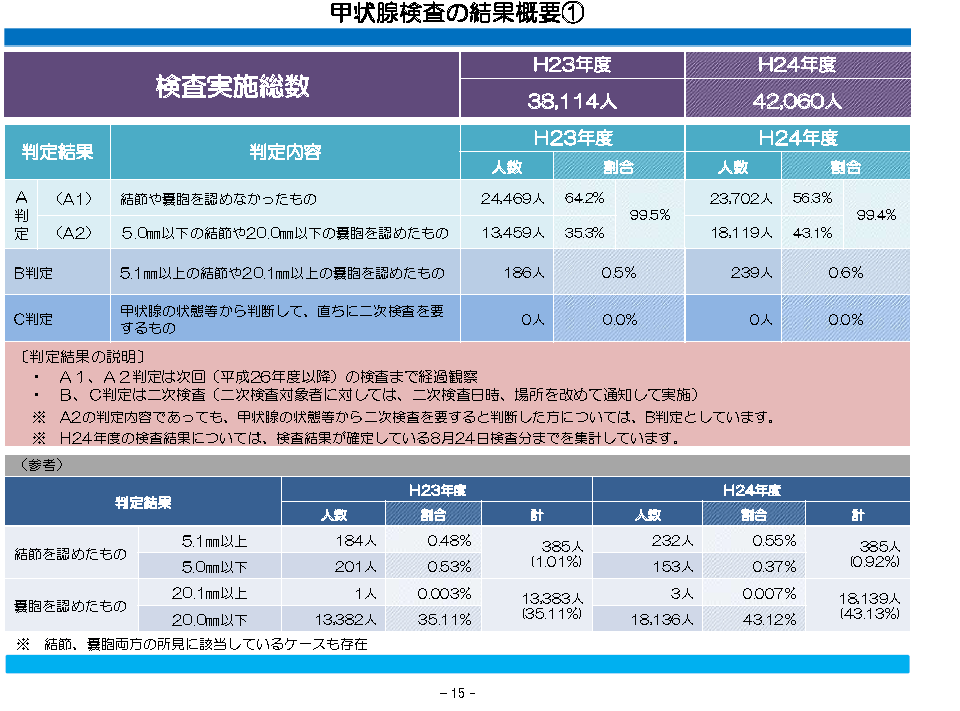
Summary of Thyroid Examination Results ①
[Explanation of assessment classifications]
・A1 and A2 will be observed until the next round of examination (after FYH26 or FY2014).
・B and C will undergo the secondary examination. (Notice of the date and place of the secondary examination will be sent to them).
※A2 will be treated as B if the thyroid gland condition warrants the need for secondary examination.
※Examination results for FYH24 (FY2012) includes completed results up to August 24, 2012.
※Some cases have both nodules and cysts.
*********
Page 16
Summary of Thyroid Examination Results ②
1. Distribution by age and gender for each assessment classification category.
(For each category the left column shows the number of boys, the middle column shows the number of girls, and the right column shows the total, based on age groups in five-year intervals.)
The upper table is for FYH23 (FY2011). The lower table is for FYH24 (FY2012), which shows the completed results up to August 24, 2012.

2. Proportion of each assessment classification category by age.
In the tables of horizontal bar graphs, the left table is for boys and the right for girls. For each age group, in five-year intervals, the top bar shows FYH23 (FY2011) and the bottom bar FYH24 (FY2012).

*********
Page 17
Details of Thyroid Examination Results (FYH23 Exam: Nodules)
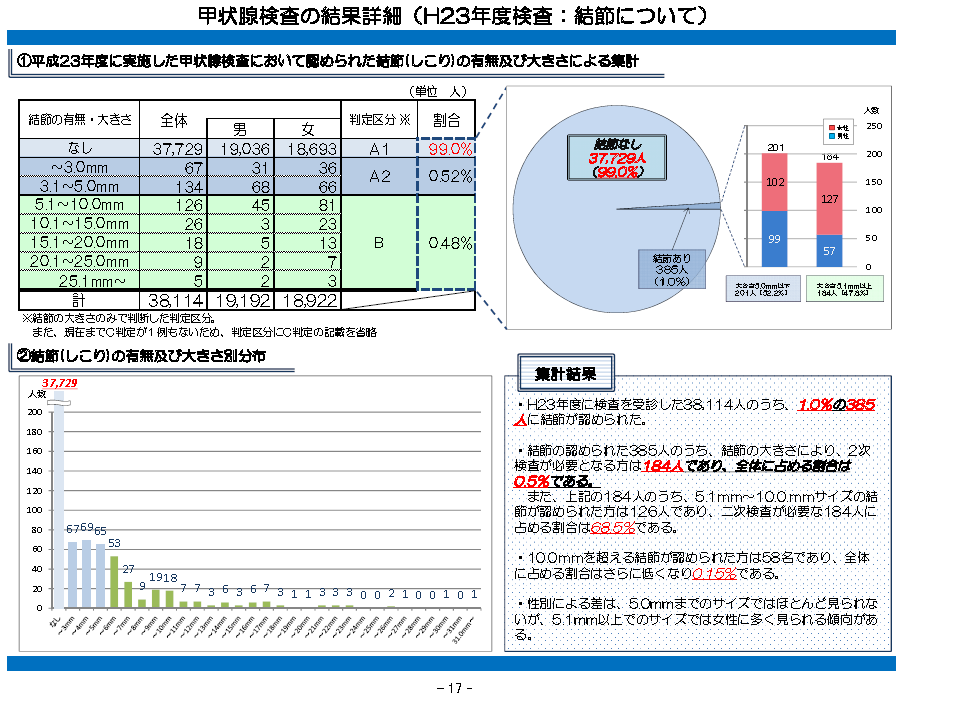
① Size breakdown of nodules found at thyroid examination conducted in FYH23 (FY2011)
※Assessment classification based on the size of the nodules alone.
In addition, category C has been omitted from the table since no cases have been classified as category C so far.
② Size distribution of nodules
Total Results
・Of 38,114 who were examined in FYH23 (FY2011), 385 or 1.0% had nodules.
・Of 385 who had nodules, 184, or 0.5% of total, required secondary examination based on the size of the nodules.
In addition, of these 184, 126 had nodules between 5.0 mm and 10.0 mm, comprising 68.5% of 184 requiring secondary examination.
・58 had nodules larger than 10.0 mm, and the proportion was even lower at 0.15%.
・Difference by gender was barely seen up to 5.0 mm, but the incidence in girls tended to be higher in sizes larger than 5.1 mm.

*********
Page 18
Details of thyroid examination results (FYH23 Exam: Cysts①)

① Size breakdown of cysts found at thyroid examination conducted in FYH23 (FY2011)
※1 Assessment classification based on the size of the cysts alone.
In addition, category C has been omitted from the table since no cases have been classified as category C so far.
※2 The reason the size group “~3.0 mm” is put together with “No cysts present” in the proportion is because in ordinary medical examination cysts smaller than 3.0 mm are treated as no cysts.
② Size distribution of cysts
Total results
・Of 38,114 who were examined in FYH23 (FY2011), 24,731 or 64.9% had no cysts.
In addition, cysts equal to or smaller than 3.0 mm are considered not to be cysts in ordinary medical examinations, and 7,036 had cysts equal to or smaller than 3.0 mm.
These two groups comprised 31,767 or 83.3% of the total examined.
・Difference by gender was barely seen up to 3.0 mm, but the incidence in girls tended to be higher in sizes larger than 3.1 mm.

*********
Page 19
Details of thyroid examination results (FYH23 Exam: Cysts②)

③ Size distribution of cysts by age groups and gender (proportion against 13,383 with cysts). (Note: for each age group, left column shows boys and right column shows girls).

④ Gender distribution by size groups (proportion against 13,383 with cysts).
(Note: Boys are shown in blue and girls in red).


Total results
・According to the bar graph showing the size distribution of cysts by age groups and gender, cysts up to 3.0 mm are seen most frequently in the age 6-10 group, with incidence gradually decreasing with increasing age.
Cysts which are 3.1 mm to 5.0 mm in size increase with age, most prominent in the age 11-15 group and decreasing in the age 16-18 group. A similar trend is seen in cysts which are 5.1 to 10.0 mm and larger than 10.1 mm.
・Difference by gender was barely seen up to 3.0 mm, but the incidence in girls tended to be higher in other sizes.
*********
Page 20
Details of Thyroid Examination Results (FYH24 Exam: Nodules)
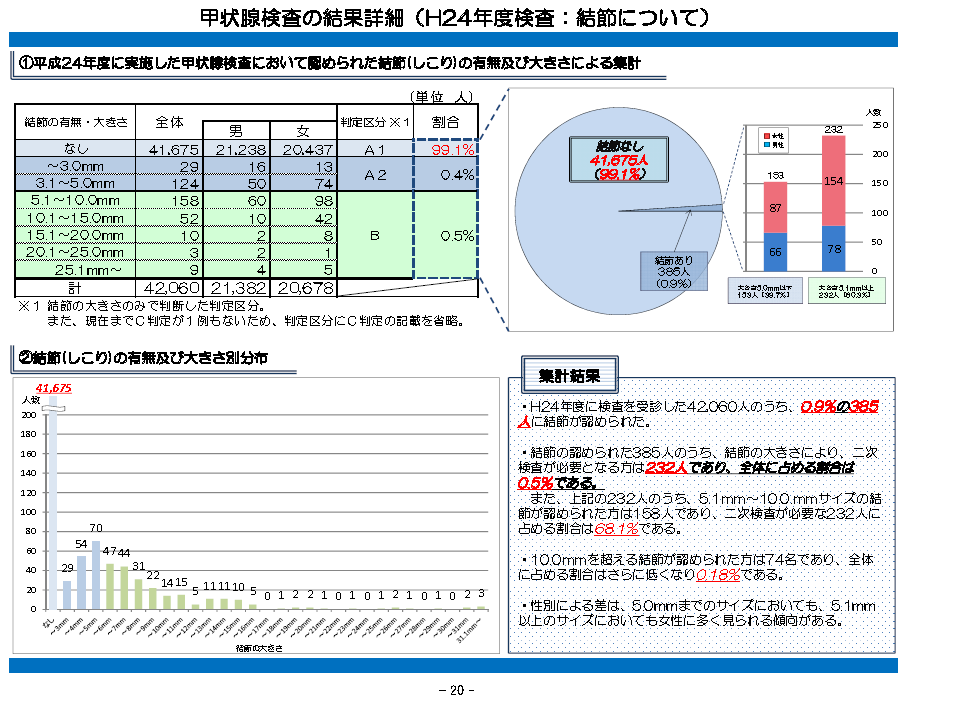
① Size breakdown of nodules found at thyroid examination conducted in FYH24 (FY2012)
※Assessment classification based on the size of the nodules alone.
In addition, category C has been omitted from the table since no cases have been classified as category C so far.
② Size distribution of nodules
Total Results
・Of 42,060 who were examined in FYH24 (FY 2012), 385 or 0.9% had nodules.
・Of 385 who had nodules, 232, or 0.5% of the total examined, had nodules large enough to require secondary examination.
In addition, 158 of the 232 mentioned above had nodules which were 5.1 mm to 10.0 mm in size, comprising 68.1% of the 232 requiring secondary examination.
・74 had nodules which were larger than 10.0 mm, and its proportion was even lower at 0.18% of the total examined.
・Difference by gender showed a tendency for more girls in both nodules up to 5.0 mm and larger than 5.1 mm.

*********
Page 21
Details of thyroid examination results (FYH24 Exam: Cysts①)

① Size breakdown of cysts found at thyroid examination conducted in FYH24 (FY2012)
※1 Assessment classification based on the size of the cysts alone.
In addition, category C has been omitted from the table since no cases have been classified as category C so far.
※2 The reason the size group “~3.0 mm” is put together with “No cysts present” in the proportion is because in ordinary medical examination cysts smaller than 3.0 mm are treated as no cysts.
② Size distribution of cysts
Total Results
・Of 42,060 who were examined in FYH24 (FY2012), 23,921 or 56.9% had no cysts.
In addition, cysts equal to or smaller than 3.0 mm are considered not to be cysts in ordinary medical examinations, and 10,424 had cysts equal to or smaller than 3.0 mm.
These two groups comprised 34,345 or 81.7% of the total examined.
・Difference by gender was barely seen up to 3.0 mm, but the incidence in girls tended to be higher in sizes larger than 3.1 mm.
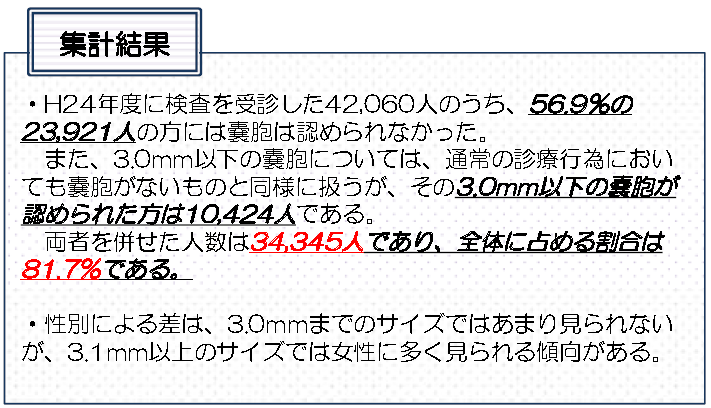
Page 22
Details of thyroid examination results (FYH24 Exam: Cysts②)
③ Size distribution of cysts by age groups and gender (proportion against 18,139 with cysts). (Note: for each age group, left column shows boys and right column shows girls).
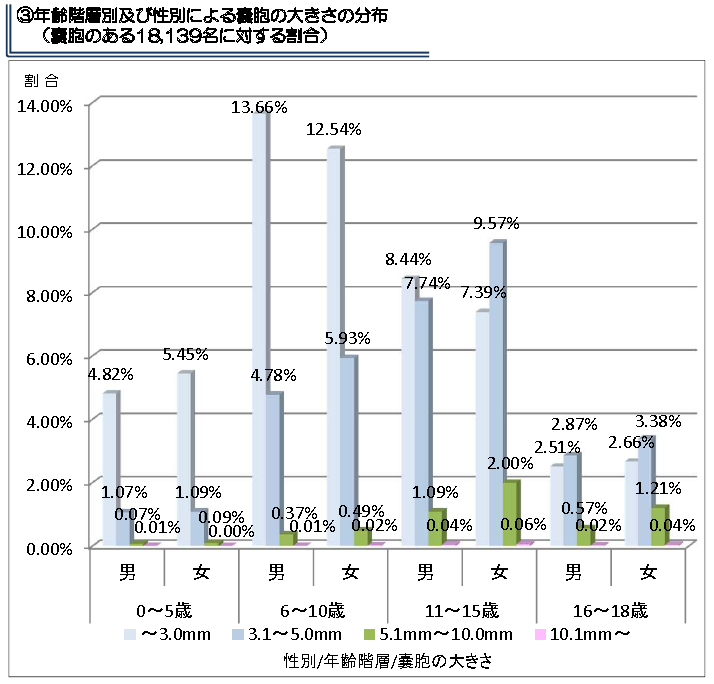
④ Gender distribution by size groups (proportion against 18,139 with cysts).
(Note: Boys are shown in blue and girls in red).

Total results
・According to the bar graph showing the size distribution of cysts by age groups and gender, cysts up to 3.0 mm are seen most frequently in the age 6-10 group, with incidence gradually decreasing with increasing age.
Cysts which are 3.1 mm to 5.0 mm in size increase with age, most prominent in the age 11-15 group and decreasing in the age 16-18 group. A similar trend is seen in cysts which are 5.1 to 10.0 mm and larger than 10.1 mm.
・Difference by gender was barely seen up to 3.0 mm, but the incidence in girls tended to be higher in other sizes.

*******
Page 23
Implementation Status of FYH24 (FY2012) Secondary Thyroid Examination

■Summary of Secondary Thyroid Examination (All-prefecture Preliminary Examination)
1. Contents of examination implemented
● If lumps (nodular lesions) are found during the primary thyroid examination, secondary examination (detailed ultrasound examination, blood test, urine test, biopsy if needed) will be conducted at Fukushima Medical University Hospital.
● A2 will be treated as B and secondary examination implemented if the thyroid gland condition warrants the need for secondary examination.
● Those qualifying for secondary examination will be notified of the time and place of the secondary examination at a later date by the Fukushima Medical University Radiation Medicine Prefecture Health Management Survey Center.
2. Examination items
● Detailed ultrasound examination: An examination using ultrasound equipment.
● Blood test: TSH (thyroid stimulating hormone), FT-3 (free triiodothyronine), FT-4 (free thyroxine), Tg (thyroglobulin), Tg-Ab (anti-thyroglobulin antibody), and TPO-Ab (anti-thyroid peroxidase antibody).
● Urine test: urinary iodine.
● Fine-needle aspiration biopsy: Cells will be aspirated from lumps in order to determine if they are benign or malignant, after detailed ultrasound examination.
3. Examination results
● As for the notification of the secondary examination results, those examined will have direct (in-person) explanation of detailed results of the secondary examination.

■ Implementation status of secondary thyroid examination (All-prefecture preliminary examination). (As of August 23, 2012)
Note: Items in the table were translated exactly how they appear in the original table.
※1 Those who will be re-checked at the standard examination after April 2014 due to the absence of abnormalities.
※2 Those who have moved onto regular medical care schedule, to be re-checked mostly 6 months to one year later.
